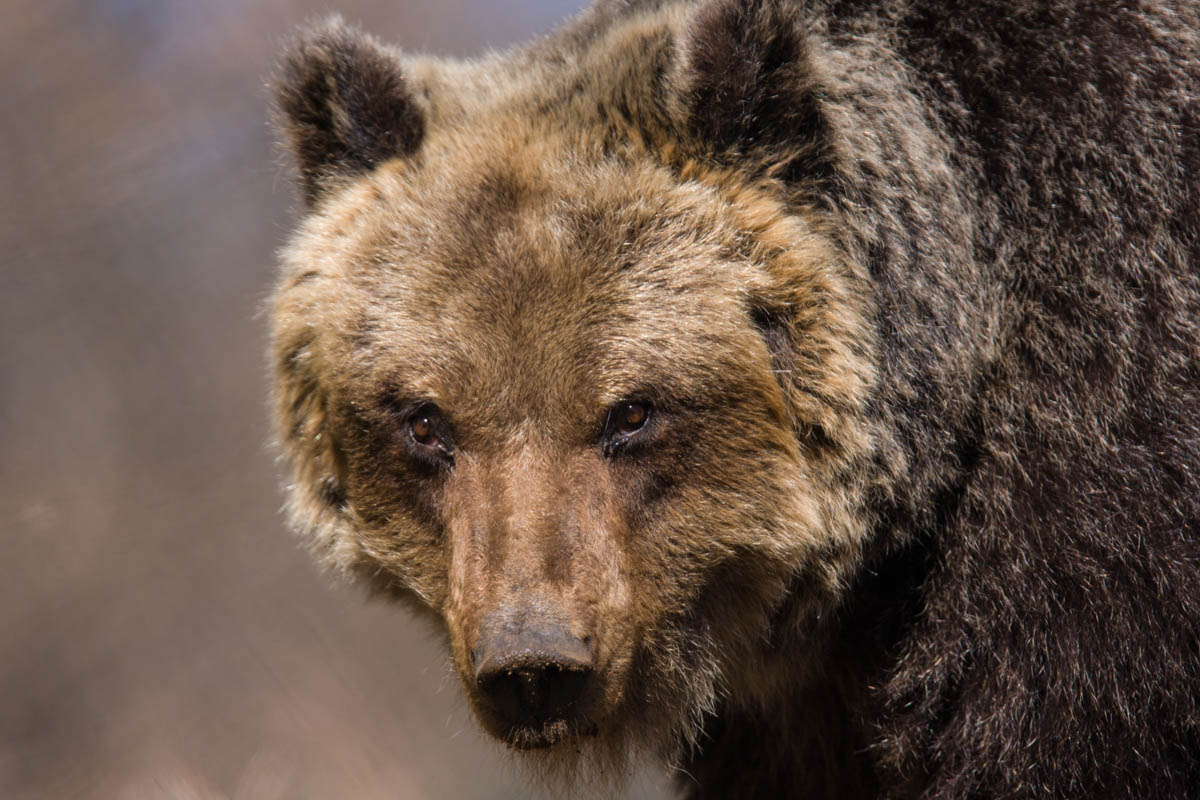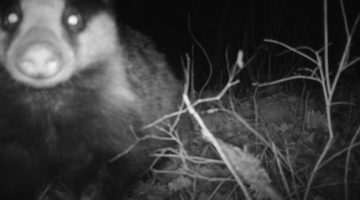Working to promote coexistence between Marsican brown bears and humans in five essential wildlife corridors, the Central Apennines rewilding team had a productive 2019. The team were encouraged in their efforts by a range of positive results and the record-breaking number of bear cubs born last year.

Essential actions
Rewilding can create favourable conditions for the spontaneous comeback of wildlife species – this is by far the most important tool for wildlife recovery in Rewilding Europe’s operational areas. In the Central Apennines of Italy, rewilding efforts are currently focused on helping the area’s endangered population of Marsican brown bears to recover by promoting human-bear coexistence in five critical wildlife corridors.
Such promotion routinely involves the Central Apennines team and their small army of invaluable volunteers in a wide range of essential actions. These are frequently carried out in collaboration with Italian NGO Salviamo l’Orso, a local Rewilding Apennines partner. Figures from last year illustrate the diversity and scale of some of these vital tasks.
- More than 24 kilometres of barbed wire removed
- 61 electric fences, 14 bear-proof metal doors and 3 bear-proof chicken houses installed
- Six remote water tanks made safe (following the tragic drowning of a Marsican brown bear female and two cubs in November 2018)
Encouraging results
When it comes to promoting human-bear coexistence, outcomes are even more important than actions. In this regard, the rewilding team were heartened by two encouraging results in 2019.
- Zero instances of bear damage in the Alto Molise coexistence corridor following protection of livestock farms and apiaries (this was previously a problem area in terms of bear damage).
- Evidence of bears feeding in abandoned orchards after trees here had been pruned by the rewilding team. Such pruning helps to reduce bear damage by diverting the animals away from orchards under cultivation.
“Both of these results show that our efforts are paying off,” says Rewilding Apennines team leader Mario Cipollone. “Community support is critical to the success of rewilding outcomes, so minimising bear damage is very important.”
Record-breaking census
For the Central Apennines rewilding team (and everyone involved with Rewilding Europe), undoubtedly the most encouraging result from the area in 2019 was the number of Marsican brown bear cubs born during the year.
A recent census carried out by the Abruzzo, Lazio and Molise National Park in the Central Apennines of Italy revealed that 16 Marsican brown bear cubs were born to nine female bears in the park and its buffer zone in 2019. As the highest figure recorded since census taking began in 2006, the positivity of this result is accentuated by the fact that 10-plus cubs have now been born in each of the last four years.
Sustaining the trend
There is no way of knowing the exact impact of rewilding efforts on bear cub numbers, but keeping bears safe as they move through corridor areas is almost certainly a factor in the population growth.
“We are obviously delighted with the bear cub numbers,” says Mario Cipollone. “It shows that given the opportunity, these magnificent bears can and will bounce back. We will continue our work, in partnership with the communities in the rewilding area, to make sure the upward trend is sustained.”
Making the connection

Despite recent population growth, the Marsican brown bear remains highly endangered, with between 60 and 70 animals (including newborns) now estimated to inhabit the Central Apennines.
While the animals are relatively safe inside the area’s national parks and reserves (mainly the Abruzzo, Lazio and Molise National Park), outside the boundaries of these areas they are still at risk from poaching, poisoning and traffic collisions. Female bears were killed in traffic accidents in August and December of 2019.
With such a small Marsican brown bear population, providing space where the animals can roam safely is vital to ensure genetic exchange. By developing the five wildlife corridors, the Central Apennines rewilding team is contributing to the creation of an interconnected network of three protected areas, a biosphere reserve and their buffer zones, with a total area of around 300,000 hectares.
Creating coexistence corridors not only helps Marsican brown bears, but other wildlife too. As this recent video from the rewilding area shows, removing barbed wire often allows a wide range of animals to their follow natural pathways (as well as removing an unsightly blot on the landscape).
Damage prevention
With bears and humans living alongside each other in corridor areas, minimising the damage that the animals could cause to local farms, smallholdings and gardens is critical in keeping relations harmonious. In this regard, damage prevention is far more effective than compensating people for destroyed property and lost income.
For the Rewilding Apennines team and partners, this typically means handing out and helping to set up and maintain electric fences, metal doors and bear-proof bins. Such actions are particularly important given the increasing Marsican brown bear population and the animals’ tendency to roam.
Socio-economic impact
When wildlife makes a comeback – either of its own accord or as a result of reintroduction – one of the best ways to promote human-animal coexistence, and to generate further support for rewilding, is to make sure local people and communities benefit economically from the resurgence. This is now happening in the Central Apennines.
Back in 2016, Rewilding Europe Capital (Rewilding Europe’s enterprise loan facility) made a 40,000-euro loan to Wildlife Adventures, a company based in the Central Apennines rewilding area offering hiking, trekking and wildlife watching. The company employs four local people, with extra guides taken on during the tourism high season.
The loan was used to restore a high-altitude shepherd’s hut, transforming the property into fantastically sited tourist accommodation. The so-called Terraegna Refuge is now marketed through the European Safari Company, and can also be booked through the Wildlife Adventures website.
More bears, more tourists

With burgeoning Marsican brown bear numbers proving an increasing attraction, more and more people are now visiting the Terraegna Refuge. Despite problems with access to the property following a landslide, around 350 guests from all over the world visited the refuge between March and December 2019.
“Having received CETS (European Charter for Sustainable Tourism) certification from the Abruzzo, Lazio and Molise National Park Authority in 2019, we are hoping for even more guests in 2020,” says Umberto Esposito, the hiking instructor and nature photographer who founded Wildlife Adventures in 2009. “The refuge has also featured in a number of international media reports, helping to raise the profile of the Marsican brown bear and local rewilding efforts.”